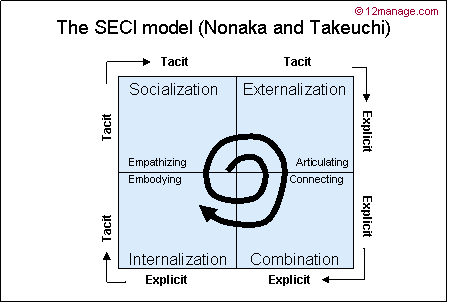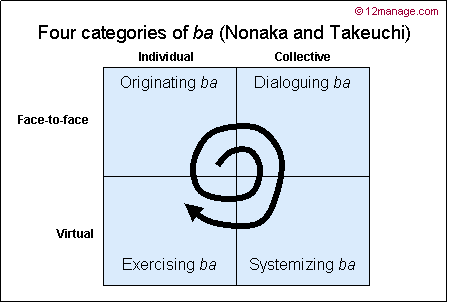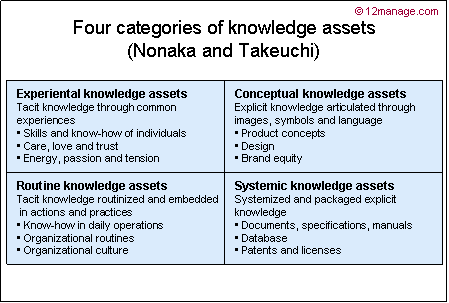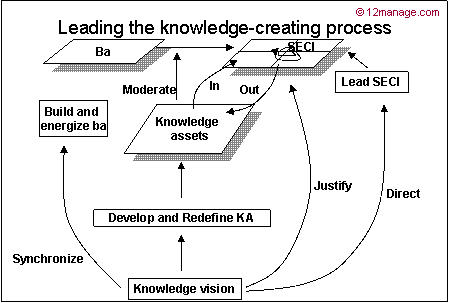Qu'est-ce que le modèle du SECI ?

Ikujiro Nonaka et Hirotaka Takeuchi proposent un modèle des connaissances créant un processus pour comprendre la nature dynamique de la création de connaissances, et pour gérer un tel processus efficacement : Le Modèle du SECI. Il se composent de 3 éléments :
- SECI
- Ba
- Capital de connaissance
Ces 3 éléments interagissent les uns avec les autres organiquement et dynamiquement. Le capital de connaissance d'une entreprise est réalisable et partagé en « Ba » attendu que la connaissance tacite (tacit knowledge) soutenue par les individus est convertie et amplifiée par la spirale des connaissances à travers la :
- Socialisation
- Externalisation
- Combinaison
- Internalisation
Les trois éléments devraient être intégrés sous le leadership clair de sorte que l'organisation puisse créer des connaissances en permanence et dynamiquement : elle doit devenir une discipline pour les membres de l'organisation.
SECI
La création des connaissances est un processus continu des interactions dynamiques entre les connaissances tacites et explicites. Les quatre modes de la conversion de connaissances interagissent dans la spirale de la création de connaissances. La spirale devient plus grande dans l'échelle pendant qu'elle s'élargit à travers les niveaux organisationnels, et peut déclencher de nouvelles spirales de création de connaissances.

Socialisation. Partager la connaissance tacite par la communication en tête à tête ou l'expérience partagée. Exemple, un apprenti.
Externalisation. Concepts en développement, qui intègrent la connaissance tacite combinée. Et qui permettent sa communication.
Combinaison. Combinaison de divers éléments de connaissances explicites : construire un prototype est un exemple.
Internalisation. Étroitement lié à l'apprentissage en faisant, les connaissances explicites deviennent une partie de la base de connaissances de l'individu (par exemple un modèle mental) et deviennent un actif pour l'organisation.
Ba
Ce concept difficile (il n'y a aucune traduction exacte du mot) peut être défini comme contexte de mise en commun dans lequel des connaissances sont partagées, créées et utilisées en interaction.
Le diagramme illustre les divers types de Ba, chacun offre un contexte pour une phase spécifique dans le processus de création de la connaissance.
Exemples des catégories, utilisant Seven-Eleven (magasins japonais de proximité) :
- Lancer (Originating Ba) : le sol du magasin, il permet au peuple pour interagir les uns avec les autres et avec des clients.
- Dialoguer (Dialoguing Ba) : la connaissance tacite les employés locaux sont utilisés pour créer des prévisions de ventes, dans le dialogue les uns avec les autres.
- Systématiser (Systemizing Ba) : les prévisions de ventes sont comparées aux résultats des ventes et sont renvoyées aux magasins locaux.
- Exercer (Exercising Ba) : utilisant cette information, et la comparant à la réalité, le personnel améliore ses qualifications et capacité de faire des prévisions.
Capital de connaissance

Ce sont des ressources spécifique à la compagnie qui sont indispensables pour créer des valeurs pour la société. Elles sont les produits en entrée, sorties, et les facteurs de modération, du processus de création de la connaissance.
Pour gérer efficacement la création et l'exploitation de connaissances, une entreprise doit « cartographier » ses stocks de capital de connaissance. Cataloguer n'est cependant pas suffisant : le capital de connaissance est dynamique ; le nouveau capital de connaissance peut être créé du capital de connaissance existant.
Le rôle du leadership est illustré dans le prochain diagramme :

Origine du Modèle du SECI. Histoire
Le modèle de Nonaka et Takeuchi est basé sur la distinction de Polanyi entre les connaissances tacites et explicites (1983) et fournit une compréhension de la création et de la gestion des connaissances d'une perspective japonaise de la culture des affaires.
Points forts du Modèle du SECI. Avantages
- Apprécie la nature dynamique des connaissances et de la création de connaissances.
- Fournit un cadre pour la gestion des processus pertinents.
Limites du Modèle du SECI. Inconvénients
- Il est basé sur une étude des organisations japonaises, qui comptent lourdement sur la connaissance tacite : les employés sont souvent dans une entreprise pour la vie.
- Les linéarités du concept : la spirale peut-elle sauter des phases ? Peut-elle aller à contre-sens horaire ?
Livre : Ikujiro Nonaka, Hirotaka Takeuchi - The Knowledge-Creating Company
|
Cours sur Modèle du SECI.

Cours pour Débutants
|

Cours Avancé
|

Cours pour Experts
|
|
|
|
Les sujets les mieux notés sur Modèle du SECI. Vous trouverez ici les idées les plus précieuses et des suggestions pratiques.
|
|
|
Idées avancées sur SECI model (Anglais). Vous trouverez ici des conseils professionnels d'experts.

Conseils de Consultation
|

Conseils Pédagogiques
|

Conseils Pratiques de Mise en �uvre
|
|
|

|
Barriers that Hinder Effective Knowledge Sharing Effective Knowledge Sharing, Pitfalls to Avoid, Knowledge Management Implementation
According to Chris Collison, there are seven common barriers or syndromes that hinder effective knowledge sharing and se...
|

|
9 Major Definitions of Knowledge Management Knowledge Management
- KM is the "process of collecting, organizing, classifying and disseminating information throughout an organization, so...
|

|
How to Identify and Map Knowledge Knowledge Identification, Knowledge Capturing, Knowledge Storage
In his article “Knowledge Mapping: The Essentials for Success”, Wesley Vestal provides following six tips to identify an...
|

|
The N-Form Organization (Hedlund) Alternate KM Framework
Gunnar Hedlund of the Stockholm School of Economics introduced the notion of the N-Form corporation in 1994. He proposed...
|

|
Critical Activities to Build a Learning Organization Implementing Organizational Learning, Best Practices
Learning organizations are distinguished because they are undertaking certain activities to foster the internal learning...
|

|
Capturing Learned Lessons How to Capture Organizational Learning? Best Practices
Knowledge from bad and good experiences will lead you and your organization to better future performance. You can improv...
|

|
Knowledge Management Scope Knowledge Management, Level of Know-how
Research by Deishin Lee (HBS) and Eric Van den Steen (MIT) shows that recording mediocre know-how can actually be counte...
|

|
Three Pillars of Knowledge Management (WiiG) Alternate KM Framework
Karl Wiig is one of the pioneers in the field of Knowledge Management and was among the first to publish a series of tex...
|

|
Components of Learning Agility Organizational Agility, Organizational Learning, Knowledge Management
One of the critical factors for achieving organizational agility is learning agility, which refers to the ability and ea...
|

|
Positive Effects of Age Diversity on Company Productivity and (Tacit) Knowledge Sharing Tacit Knowledge Transfer, Workforce Productivity, Incentive Management
Backes-Gellner and Veen (2013) outlined the main advantages of having a diverse workforce within a company. The followin...
|

|
Knowledge Management Focal Point Knowledge Management Focus
Research by Deishin Lee (HBS) and Eric Van den Steen (MIT) shows that information about successes is typically more usef...
|
|
|
|
Diverses sources d'informations sur Modèle du SECI. Vous trouverez ici des powerpoints, des vidéos, des actualités, etc. à utiliser dans vos propres conférences et ateliers.

|
Revisiting Knowledge Management Integrating Knower with the Knowledge Processes
Very good paper by Madhukar Shukla gives historic overview of KM, 3 dimensions of KM and future directions of KM....
|

|
How Businesses can Use Information Technology (IT) in Strategic Ways Strategic Management, Information Technology
This presentation looks at Information Technology from a strategic point of view. In other words, it discusses in what w...
|

|
People and Latent Knowledge in Organizational Learning Knowledge Creation, Explicit Knowledge, Tacit Knowledge
Knowledge management theory has struggled with the concept of knowledge creation. Since the seminal article of Nonaka in...
|

|
How to Improve Knowledge Sharing in Knowledge-intensive Organizations Knowledge Management, Knowledge Sharing Motivation, Knowledge Sharing Platform. Tacit Knowledge
This presentation elaborates on the concept of knowledge sharing, thereby focusin on a knowledge-intensive organization ...
|

|
Introduction to Knowledge Management: Foundation Principles and Building Concepts Knowledge Management, Knowledge Sharing, Learning Organization
1. What is Knowledge?
1. What is Knowledge Management? Definition
2. Knowledge Foundation Principles and Building Conc...
|

|
Knowledge Transfer and Knowledge Sharing Knowledge Management, Knowledge Sharing, Knowledge Transfer
Preentation that is an introduction into the concept of Knowledge Transfer, including its fundamentals, strategies, guid...
|

|
Overview of Existing Types of Knowledge Knowledge Management, Knowledge Types, Tacit, Implicit, Explicit, Declarative, Procedural Knowledge
This presentation provides an overview of the different types of knowledge that exist. The presentation includes the fol...
|

|
Knowledge Management Systems Architecture Knowledge Management, Knowledge Creation, Knowledge Systems, Knowledge Architecture
This presentation is about knowledge development and management, including the following sections:
1. Overview
2. Know...
|

|
How to Integrate Internal Organizational Knowledge with External Online Communities Knowledge Management, Knowledge Creation, Knowledge Sharing, Interaction, Knowledge in Organizations
Due to many online and web-based technological developments in today´s digital economy, sharing knowledge in online comm...
|

|
Leveraging Cognition for Competitive Advantage:A Knowledge-Based Strategy Process Knowledge-intensive firms
Article by Senthil K. Muthusamy and Ramaraj Palanisamy. One of the central bases for achieving competitive advantage is ...
|

|
Discovering Knowledge Management Forces Healthcare
This paper by Khalid Samara is an ongoing research in the area of knowledge management (KM) and evidence-based practice ...
|

|
Introduction and Summary of SECI Initial Understanding of SECI. Start of workshop/training
Knowledge Management
Is utilizing tacit (the unseen huge part of the iceberg), as well as explicit (the tip of the iceb...
|

|
Knowledge Creation: The SECI Model Knowledge Management, Knowledge Creation
Presentation about the SECI model of Nonaka and Takeuchi (1996), a model about knowledge creation. The model is based on...
|

|
Knowledge Sharing and Organizational Learning through Communities of Practices Knowledge Sharing, Organizational Learning, Communities of Practices, Special Interest Groups
Knowledge management in Communities of Practice (CoPs)
This presentation is about organizational learning and knowledge...
|

|
SECI Model Diagrams Knowledge Management
Download and edit these 12manage PowerPoint graphics for limited personal, educational and business use.
Republishing i...
|

|
Knowledge Transfer in the E-world Knowledge Management, Knowledge Transfer, Internet, Intranet, E-Business, CRM
This is a presentation about Knowledge Transfer (KT), specifically focused on KT in the e-world. The presentation consis...
|

|
3 Pillars of KM Knowledge Management
Three Pillars of Knowledge Management (Wiig)....
|

|
N-Form Organization Knowledge Management
The Dynamics of Knowledge Management in an N-Form Organization....
|
|
|
|
Outils utiles concernant Modèle du SECI.

Nouvelles
|

Vidéos
|

Présentations
|
| |

Livres
|

Académique
|

Plus
|
|
|
|
Comparez le Modèle du SECI avec : Mise en Relation des Epistémologies | l'Organisation Apprenante | Mémoire de l'Organisation | Apprentissage par l'Action
| Gestion de la Connaissance (Collison et Parcell)
Retour vers la page des disciplines de Management : Connaissance et Immatériel | Leadership
Plus de Méthodes, Modèles et Théorie de Management
|
|
|
















